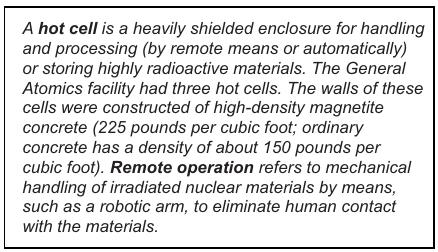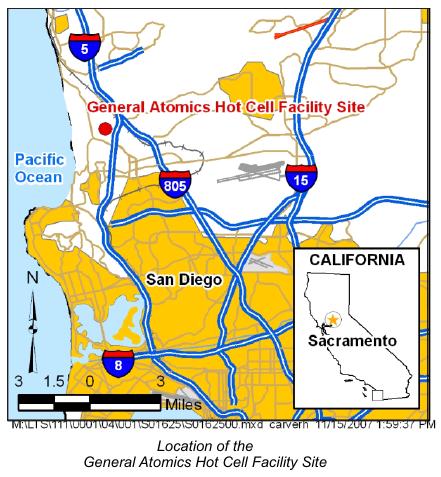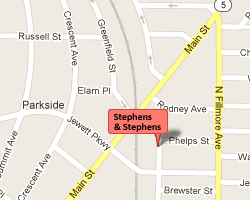General Atomics
Also Known As: GA, Division of General Dynamics, John Jay Hopkins Laboratory for Pure and Applied Science
State: California
Location: La Jolla
Time Period: BE 1959-1967; AWE 1960-1969; Residual Radiation 1970- 1995, 2000; DOE 1996-1999 (remediation)
Facility Type: Atomic Weapons Employer (AWE), Beryllium Vendor (BE), Department of Energy (DOE)
Facility Description
General Atomics was one of a number of private contractors that processed unirradiated scrap for the Atomic Energy Commission in the 1960s. In addition, the Hot Cell Facility was used for numerous post-irradiation examinations of Department fuels, structural materials, reactor dosimetry materials, and instrumentation. The Department- sponsored activities at the General Atomics Hot Cell Facility primarily supported the High Temperature Gas Cooled Reactor and the Reduced Enrichment Research Test Reactor programs. In December 1994, General Atomics notified the Nuclear Regulatory Commission and the State of California Department of Health Services of its intent to cease operations in the Hot Cell Facility.
General Atomics was also the operating contractor for the AEC’s Experimental Beryllium Oxide Reactor (EBOR). General Atomics manufactured EBOR fuel elements (UO2-BeO) on site and examined them in the site’s hot cell.
During the period of residual contamination, as designated by the National Institute for Occupational Safety and Health and as noted in the dates above, employees of subsequent owners and operators of this facility are also covered under the Energy Employees Occupational Illness Compensation Program Act.
Listing
General Atomics is listed as a Department of Energy (DOE) site from 1960 – 1969, as Beryllium Employer (BE) site from 1959-1967 , and as an Atomic Weapons Employer (AWE) from 1960 -1995.
The Special Exposure Cohort dates for General Atomics are from 1960 -1969
SEC Classes
Atomic Weapons Employer (AWE) employees who were monitored or should have been monitored for exposure to ionizing radiation while working at the General Atomics facility in La Jolla, California at the following locations: Science Laboratories A, B, and C (Building 2); Experimental Building (Building 9); Maintenance (Building 10); Service Building (Building 11); Buildings 21 and 22; Hot Cell Facility (Building 23); Waste Yard (Buildings 25 and 26); Experimental Area (Buildings 27 and 27-1); LINAC Complex (Building 30); HTGR-TCF (Building 31); Fusion Building (Building 33); Fusion Doublet III (Building 34); SV-A (Building 37); SV-B (Building 39); and SV-D (no building number) for a number of work days aggregating at least 250 work days from January 1, 1960, through December 31, 1969, or in combination with work days within the parameters established for one or more other classes of employees in the SEC.
All Atomic Weapons Employees who worked for General Atomics at its facility in La Jolla, California, during the period from January 1, 1960, through December 31, 1969, for a number of work days aggregating at least 250 work days, occurring either solely under this employment, or in combination with work days within the parameters established for one or more other classes of employees included in the Special Exposure Cohort.
This class was established by Petition 218.
Compensation
As of 08/2015, the total compensation paid under Parts B and E of the EEOICPA, including medical compensation, for workers suffering from the effects of having worked at General Atomics is $20,258,489.
General Atomics Workers
If you or your parent worked at this or any other DOE or AWE facility and became ill, you may be entitled to compensation of up to $400K plus medical benefits from the US Department of Labor. Call EEOICPA Counsel Hugh Stephens at 1-855-EEOICPA (336-4272) or fill out the form to the right, whether or not you have already filed a claim and even if your claim has been accepted or denied.
We can help with all OWCP (Federal Workers Compensation) claims, impairments, wage loss and health care. 2495 Main Street, Suite 442 Buffalo, NY.
Job Titles and/or Job Duties
Potentially worked in the locations–
- Building 2 (Science laboratories A, B, and C)
- Building 9 (Experimental Building)
- Building 10 (Maintenance)
- Building 11 (Service Building)
- Building 21
- Building 22
- Building 23 (Hot Cell Facility)
- Building 25
- Building 26
- Building 27 (Experimental Area Building #1)
- Building 27-1 (Experimental Area Building #1)
- Building 30 (LINAC Complex)
- Building 31 (HTGR-TCF)
- Building 33 (Fusion Building)
- Building 34 (Fusion Doublet III)
- Building 37 (SV-A)
- Building 39 (SV-B)
- SV-D
Period of Employment
January 1, 1960, through December 31, 1969
History
In 1955, General Atomics (GA) was formed as a division of General Dynamics in San Diego, California. Its purpose was to develop beneficial technologies using nuclear energy. Since that time, GA has carried out research dealing with the nuclear fuel cycle, electromagnetic systems, remotely operated surveillance aircraft, and other technologies.
NIOSH site profile
General Site Description And Operational History
General Dynamics Corporation acquired property in La Jolla, California, in 1956 where the John J.
Hopkins Laboratory for Pure & Applied Science – later named the General Atomic Division of General Dynamics facility – was built. The information that follows applies to a period of AEC radiological operations at GA in La Jolla, California, from January 1, 1960, to December 31, 1969. This document assumes that the residual contamination period was from January 1, 1970, through December 31, 1995. DOE remediation activities are listed by the DOE Office of Worker Advocacy and are assumed to run from January 1, 1996, through December 31, 1999. Although beryllium exposure is not considered in this part of the program, it is noted that the covered period for beryllium began a year before the period for radiation exposure.
The GA source term includes depleted, normal, and highly enriched uranium (typically greater than
20% and up to 93.5% 235U by mass) in the form of scrap and reactor fuel both in a fresh form and in an irradiated form that includes uranium as well as activation and fission products. Thorium was used in fuel fabrication work. Plutonium work also occurred on the site. Four linear accelerators (LINACs) and several nuclear reactors were also available. Sealed sources were used for instrument calibrations and other work. Byproduct materials (atomic numbers 3 to 83) and tritium were also used.
According to a company pamphlet, General Dynamics Corporation established General Atomic
Division on July 18, 1955, in San Diego, California, to develop commercial applications for nuclear technology. GA was also known as John Jay Hopkins Laboratory for Pure and Applied Science; Gulf General Atomic; Gulf General Atomics Company; Gulf Energy & Environmental Systems; and GA Technologies. At one point they were held in partnership between Gulf Oil Corporation and Scallop Nuclear, and the partnership was known as Valley Pin Associates.
Site Description
The current GA main site, a 60-acre complex on Torrey Pines Mesa in La Jolla, California (GA 1998), is the facility location that is covered by EEOICPA. The main site is approximately 300 ft above sea level, 1 mi from the Pacific Ocean, and 13 mi northwest of downtown San Diego. The GA site is in the center of Torrey Mesa Science Center, a 304-acre industrial park. The majority of GA buildings are on top of the mesa, but some work [e.g., at the Fuel Fabrication Facility (Building 37)] and the Fusion Energy Facility (also known as DIII-D National Fusion Facility) occurred (and some still occurs) at the base of the mesa to the east of the central set of site buildings.
Radiological work at facilities on the mesa included the HCF (Building 23) activities; Training, Research, Isotopes, General Atomics (TRIGA) reactor facilities activities; LINAC work; and neutron studies. In addition, research and development, including metallurgical and chemistry work, was occurring in the Science Laboratory and Experimental Buildings. The Fuel Fabrication Facility and the HCF were both in operation by the end of the 1950s. The HCF included support for high-temperature gas-cooled reactor (HTGR) and TRIGA reactor fuel research and development. Beginning in October 1966, a Plutonium Laboratory that was equipped with gloveboxes and high-efficiency particulate air (HEPA) filtration exhaust systems was activated for the first time in the HCF (Gurren 1966a).
General Dynamics/Convair work at the Kearny Mesa Site in San Diego, California, which is not listed as a covered facility by the DOE Office of Worker Advocacy, is not specifically considered in this site profile, but is mentioned because
of the possibility that dosimetry records for some workers might include exposures from both the San Diego site and the La Jolla site. Work on the Experimental Beryllium Oxide Reactor (EBOR) project might have occurred both in California and at the Idaho National Laboratory, and dosimetry records from both sites might be needed to reconstruct dose for these workers.
GA possessed and used radioactive materials under several licenses and its radiological programs
were regulated by the Federal Government and the State of California.
Site Description and History
The former General Atomics Hot Cell Facility was constructed in 1959 and operated until 1991. The site encompassed approximately 7,400 square feet of laboratory and remote operations cells. Licensed operations at the facility included receipt, handling, and shipment of radioactive materials; remote handling, examination, and storage of previously irradiated nuclear fuel materials; pilot-scale tritium extraction operations; and development, fabrication, and inspection of uranium oxide–beryllium oxide fuel materials. General Atomics performed most of the work for the federal government.
The General Atomics Hot Cell Facility was located in a 60-acre complex 13 miles northwest of downtown San Diego, 1 mile inland from the Pacific Ocean, and approximately 300 feet above sea level. The General Atomics site is in the center of Torrey Mesa Science Center, a 304-acre industrial park. No groundwater wells are at or near the Hot Cell Facility. Regional hydrogeologic data indicate that the uppermost aquifer is about 300 feet below ground surface at the site.
Because of a significant decline in the projected use of the facility, a decline in nuclear fission research, and increasing industrial development surrounding the General Atomics site in the early 1990s, General Atomics’ management decided to decontaminate and decommission the Hot Cell Facility and remediate the associated yard area. General Atomics requested assistance from the U.S. Department of Energy (DOE).
Discussions between DOE and General Atomics led to an agreed cost-sharing and no-fee arrangement for the decontamination and site remediation prorated on the basis of facility usage by the federal government. After an examination of records, the cost shares were calculated to be 76 percent federal work and 24 percent commercial work. Work began in 1993 to inventory the material and equipment in the facility for disposal, dispose of legacy waste from previous contracts, determine the magnitude and extent of contamination, and prepare a decontamination and decommissioning plan and supporting documents.
The main source of radioactive contaminants at the facility were nuclear materials and fission/activation products in previously irradiated fuel materials. The facility also had lesser amounts of nonradioactive hazardous waste consisting of asbestos and lead. The total activity of all radionuclides in the irradiated fuel materials, decayed to a reference date of September 30, 2003, was about 2,660 curies.
Wastes from the Hot Cell Facility dismantlement and subsequent site cleanup activities consisted of removing radioactively contaminated soil, asphalt, concrete rubble, construction material debris, and facility equipment.
Selected materials and equipment were removed from the facility in 1995 and salvaged for reuse or packaged for disposal. Contaminated systems were shipped to a low-level radioactive waste disposal facility. Decontamination of the hot cells used a variety of techniques; the predominant one was abrasive cleaning of the concrete surfaces. Interiors of the hot cells were cleaned using remotely operated cleaning methods followed by abrasive cleaning. When all loose contami- nation had been removed and the cells cleaned, the building was surveyed for radioactivity and dismantled. Material with no radioactive contamination was disposed of as “clean” waste, and material with contamination that could not be removed was shipped off site for burial as contaminated low-level radioactive waste. Buried items, including wells, hot drain lines, and high-efficiency air particulate ducting, were excavated and shipped off site for disposal. Remediation of the yard area was followed by radiological surveys and additional remediation until release criteria were met in all areas. The Hot Cell Facility site was released for unrestricted use by the U.S. Nuclear Regulatory Commission (NRC) in July 2000 and by the State of California Department of Health Services in August 2000.
DOE-owned legacy irradiated fuel materials from the site were shipped to the Idaho National Engineering and Environmental Laboratory at Idaho Falls, Idaho, for interim storage. Of the radioactive waste shipped off site for permanent disposal, 94,438 cubic feet went to the Hanford, Washington, facility; 60,524 cubic feet went to Envirocare, LLC, near Salt Lake City, Utah; 57,659 cubic feet went to the Nevada Test Site; and 486 cubic feet was shipped to various smaller facilities.


DOCUMENTS
NIOSH
Petition 64 (Jan 1, 1960 to Dec 31, 1969)
SEC Petition Evaluation Report, Petition SEC-00064, Report Rev # 1 Report Submittal Date 09-20-06
Petition 218 (Jan 1, 1960 to Dec 31, 1969)
SEC Petition Evaluation Report, Petition SEC-00218, Report Rev #:0 Report Submittal Date: July 17, 2014
Technical Basis Documents
Site Profile
Site Profile for General Atomics, 09/26/2008
Share this:
EEOICPA CLAIMS
If you or your parent worked any of the DOE or AWE facilities listed on this website and became ill, you may be entitled to compensation of up to $400K plus medical benefits from the US Department of Labor.
Call EEOICPA Counsel Hugh Stephens at 1-800-548-4494, email hstephens@stephensstephens.com, or fill out the form below whether or not you have already filed a claim and even if your claim has been accepted or denied.
Contact Us
"*" indicates required fields
*note: Submission of this form does not establish an attorney-client privilege.
Contact Us
Address:
2495 Main Street, Suite 442
Buffalo, New York 14214
Phone:
(716) 852-7590
Fax:
(716) 852-7599
After Hours:
(716) 208-3525
Email Us:
R. William Stephens, Esq.
R. Hugh Stephens, Esq.
Lisa P. Neff, Esq.

